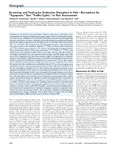Screening and Testing for Endocrine Disruption in Fish—Biomarkers As “Signposts,” Not “Traffic Lights,” in Risk Assessment
| dc.contributor.author | Hutchinson, TH | |
| dc.contributor.author | Ankley, GT | |
| dc.contributor.author | Segner, H | |
| dc.contributor.author | Tyler, CR | |
| dc.date.accessioned | 2017-05-17T08:47:07Z | |
| dc.date.available | 2017-05-17T08:47:07Z | |
| dc.date.issued | 2006-04 | |
| dc.identifier.issn | 0091-6765 | |
| dc.identifier.issn | 1552-9924 | |
| dc.identifier.uri | http://hdl.handle.net/10026.1/9259 | |
| dc.description.abstract |
Biomarkers are currently best used as mechanistic "signposts" rather than as "traffic lights" in the environmental risk assessment of endocrine-disrupting chemicals (EDCs). In field studies, biomarkers of exposure [e.g., vitellogenin (VTG) induction in male fish] are powerful tools for tracking single substances and mixtures of concern. Biomarkers also provide linkage between field and laboratory data, thereby playing an important role in directing the need for and design of fish chronic tests for EDCs. It is the adverse effect end points (e.g., altered development, growth, and/or reproduction) from such tests that are most valuable for calculating adverseNOEC (no observed effect concentration) or adverseEC10 (effective concentration for a 10% response) and subsequently deriving predicted no effect concentrations (PNECs). With current uncertainties, biomarkerNOEC or biomarkerEC10 data should not be used in isolation to derive PNECs. In the future, however, there may be scope to increasingly use biomarker data in environmental decision making, if plausible linkages can be made across levels of organization such that adverse outcomes might be envisaged relative to biomarker responses. For biomarkers to fulfil their potential, they should be mechanistically relevant and reproducible (as measured by interlaboratory comparisons of the same protocol). VTG is a good example of such a biomarker in that it provides an insight to the mode of action (estrogenicity) that is vital to fish reproductive health. Interlaboratory reproducibility data for VTG are also encouraging; recent comparisons (using the same immunoassay protocol) have provided coefficients of variation (CVs) of 38-55% (comparable to published CVs of 19-58% for fish survival and growth end points used in regulatory test guidelines). While concern over environmental xenoestrogens has led to the evaluation of reproductive biomarkers in fish, it must be remembered that many substances act via diverse mechanisms of action such that the environmental risk assessment for EDCs is a broad and complex issue. Also, biomarkers such as secondary sexual characteristics, gonadosomatic indices, plasma steroids, and gonadal histology have significant potential for guiding interspecies assessments of EDCs and designing fish chronic tests. To strengthen the utility of EDC biomarkers in fish, we need to establish a historical control database (also considering natural variability) to help differentiate between statistically detectable versus biologically significant responses. In conclusion, as research continues to develop a range of useful EDC biomarkers, environmental decision-making needs to move forward, and it is proposed that the "biomarkers as signposts" approach is a pragmatic way forward in the current risk assessment of EDCs. | |
| dc.format.extent | 106-114 | |
| dc.format.medium | ||
| dc.language | en | |
| dc.language.iso | eng | |
| dc.publisher | Environmental Health Perspectives | |
| dc.subject | aquatic | |
| dc.subject | biomarkers | |
| dc.subject | ecotoxicology | |
| dc.subject | fish | |
| dc.subject | endocrine disruptor | |
| dc.subject | estrogen | |
| dc.subject | vitellogenin | |
| dc.title | Screening and Testing for Endocrine Disruption in Fish—Biomarkers As “Signposts,” Not “Traffic Lights,” in Risk Assessment | |
| dc.type | journal-article | |
| dc.type | Article | |
| dc.type | Proceedings Paper | |
| plymouth.author-url | https://www.ncbi.nlm.nih.gov/pubmed/16818255 | |
| plymouth.issue | Suppl 1 | |
| plymouth.volume | 114 | |
| plymouth.publication-status | Published | |
| plymouth.journal | Environmental Health Perspectives | |
| dc.identifier.doi | 10.1289/ehp.8062 | |
| plymouth.organisational-group | /Plymouth | |
| plymouth.organisational-group | /Plymouth/Research Groups | |
| plymouth.organisational-group | /Plymouth/Research Groups/BEACh | |
| plymouth.organisational-group | /Plymouth/Users by role | |
| dc.publisher.place | United States | |
| dc.identifier.eissn | 1552-9924 | |
| dc.rights.embargoperiod | Not known | |
| rioxxterms.versionofrecord | 10.1289/ehp.8062 | |
| rioxxterms.licenseref.uri | http://www.rioxx.net/licenses/all-rights-reserved | |
| rioxxterms.type | Journal Article/Review |


